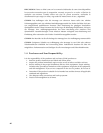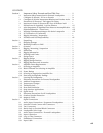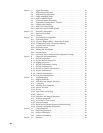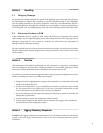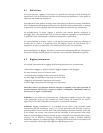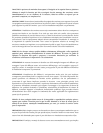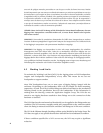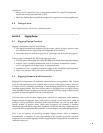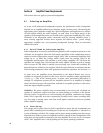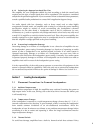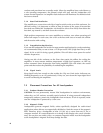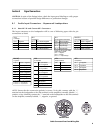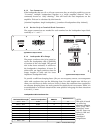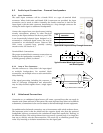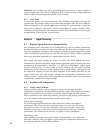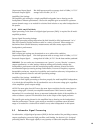
Section 6 Amplifier Power Requirements
This section does not apply to powered loudspeakers.
6.1 Selecting an Amplifier
As is true of all professional loudspeaker systems, the performance of the loudspeaker
depends on an amplifier delivering an adequate supply of clean power. Determining the
appropriate power amplifier wattage for a given loudspeaker and application is a subject
of some debate within the audio industry. As such, there is no single answer to the
question of what amplifier power you should use for a particular loudspeaker. The "Rule-
of-Thumb" is an all-purpose metric commonly used for selecting amplifier power. A
more exacting approach involves three separate and distinct issues: power ratings,
appropriate amplifier size, and preventing loudspeaker damage. These are discussed
within this section.
6.1.1 Rule-Of-Thumb For Selecting An Amplifier
If the loudspeakers are used for professional application with competent operators, a rule
of thumb can be applied. Where the full output capabilities of the loudspeakers may be
needed to achieve appropriate acoustic output levels, EAW recommends amplifiers with
ratings up to 1.4 times the voltage, which equals twice the wattage, listed in the
loudspeaker specifications. This provides a peak voltage capability of 6 dB above the
specified rms voltage limit. This assumes the audio signals will have a peak to average
ratio in excess of 6 dB, which is usually, but not always, true. Under this condition, the
thermal limits are unlikely to be exceeded. While this rule of thumb is consistent with the
EAW's testing parameters, it does NOT guarantee trouble-free operation. See Section 6.1.4
In some cases, the amplifier power determined by the Rule-of-Thumb may not be
available in acceptable products. In this event, select an amplifier within approximately
+/-25% (+/- 1 dB) of the desired power. In some cases, particularly subwoofers or
multiple LF subsystems powered off one amplifier channel or an amplifier in bridged
mode, the desired power will exceed that available in acceptable products. In this event,
select the largest amplifier possible.
WARNING: The power amplifier sizes recommended by the above rule of thumb are
capable of continuous output levels that can cause damage to or failure of the drivers.
Exercise caution in operation to avoid exceeding the specified, maximum rms voltage
limits. This is especially true when reproducing recorded music. Many recordings have
very low peak to average ratios such that much higher continuous levels are possible
before amplifier clipping.
6.1.2 Power Ratings
The voltage and/or power listed in EAW's specifications mean that the loudspeaker has
passed EAW's standard power-handling test. In this test, the loudspeaker is "exercised" to
a point of damage or failure. The voltage and/or power ratings resulting from this test are
intended to be used as a point of comparison with the ratings of other loudspeakers. This
rating does not necessarily correspond to the best amplifier size to use nor is it a measure
of the "safe" amplifier size to use depending on the actual operating conditions.
6



